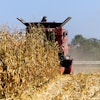
Insect infestation in stored grain is serious business. The United States Department of Agriculture (USDA) estimates that annual postharvest losses due to insects are as high as $2.5 billion. Protecting commodities from this pest activity requires commitment and planning that will pay off over the long term.
Any type of pest management requires knowledge and understanding of the pest. All pests require three basic resources to survive and reproduce: food, water and shelter (described as space, sustainable temperature and sustainable humidity). Understanding these basic requirements, it is clear that utilizing pesticides is not the only solution to managing insect infestations in stored grains.
Taking an integrated approach to managing these pests is critical to effectively eliminate the problem. While many aspects of integrated pest management (IPM) may seem too difficult, too time-consuming and/or too expensive compared to utilizing insecticides alone, over time, investment in the non-chemical controls described below coupled with applying the right insecticides at the right time will result in an effective management result.
An easy way to organize your IPM strategy is by using SLAM, which is short for sanitation, loading, aeration and monitoring. This strategy factors in multiple variables that should be considered in your plan, including crop variety, production and harvest practices, grain handling equipment, drying systems, and storage management. The ultimate objective of a SLAM strategy is to maintain the quality of your harvested grains by protecting them from weather, rodents, insects and molds through four simple steps.
Sanitation
Sanitation of the storage site (both the surrounding grounds and the storage structures/bins themselves) contributes significantly to reducing the presence of those three essential resources that allow pest species to survive between harvests and storage cycles. By eliminating or reducing resources, you’ll be a step ahead in reducing the potential for infestations in new grains coming on-site.
Site sanitation requires monitoring of the entire working area and the equipment that is used to move grains through the site. In the first instance, any spilled grain should be removed and/or destroyed as soon as possible. Remember that many pest insects can survive outside the bins if resource sites, like spilled grain piles, are available to them. Ignoring these conditions puts new harvests at higher risks of infestation down the road.
Secondly, all equipment used to move grain should be inspected on a regular basis for operational functions and to remove any accumulated grain, fragments and dust wherever possible. Small accumulations of grain and grain dust can become “anchor” harborages for both primary insect pest species and secondary species that may not be a high priority but can cause audit and grading problems nonetheless. Remember that spilled grain can attract non-insect pests like birds and rodents, which can also cause problems.
This rule applies to installed equipment as well as vehicles and trailers used at the site. Collected grain and residues should be destroyed or removed from the site as soon as possible.
Another aspect of site sanitation that must be addressed is vegetation management. Native grasses and weeds should not be allowed to grow unchecked around the site and certainly not directly adjacent to storage bins. Neglected vegetation provides easy shelter for grain pests, and flowering weeds also produce pollen that many beetle pests may utilize for food. Keep grasses and ground covers mowed short. If flowering weeds are common on the site, consider a vegetation management product like Bayer’s Esplanade® EZ herbicide, a nonselective herbicide that can provide up to six months of control of over 40 grasses and broadleaf weeds.
The second level of sanitation required is in the bins. Before filling any bin, it is recommended that it is checked carefully for any leftover grain from the previous fill. Remove all residual grain and debris, being sure to clean the bin from top to bottom and paying close attention to seams, hatches and augers.
During the bin cleaning process, you will also want to perform an inspection for bin integrity inside and outside. A key part of effective pest control is physical exclusion from your site. Think of your bins as ships on the ocean. Any structural leaks, no matter how small, must be addressed.
Prior to filling, consider treating the bin with a residual insecticide. If there has been previous pest activity in the bin or on-site, a bin treatment can be a wise investment. Bayer offers two proven insecticide concentrates that provide fast knockdown and extended residual protection on treated surfaces. Tempo® SC Ultra insecticide is a suspension concentrate formulation containing beta-cyfluthrin. Suspend® SC insecticide is a suspension concentrate that contains deltamethrin.
When using either product, after diluting with water according to label directions, apply the spray solution at the rate of 1 gallon per 1,000 square feet of surface area in bins, rail cars, truck beds and other areas where grains are stored. Allow treatments to fully dry before filling/handling with grain. It is also highly recommended that a perimeter treatment be performed around the exterior of the site. Apply a band treatment to soil or grass from the bin foundation out 10 feet around the entire structure and up the walls to a height of 2 to 3 feet. Thoroughly and uniformly wet the barrier area but do not allow runoff to occur.
Bins with false floors and augers can harbor stored grain pests in grain and dust that accumulates over time in these difficult-to-maintain voids. Bayer’s DeltaDust® insecticide is an effective deltamethrin-containing dust formulation with a unique waterproof carrier. DeltaDust insecticide deposits can be totally submerged in water and remain effective after drying. Dusts provide extended residual control of insects and may be applied throughout voids such as false floors and augers prior to filling.
Loading
Loading of grain into the bin must be done strategically. To improve air circulation, grain should be evenly spread as it enters the storage facility. If desired, insect control products, acting as grain protectants, can be distributed on the grain as it is loaded into the storage site.
Bayer offers two insecticides for on-grain treatments. As noted previously, Suspend SC insecticide, our deltamethrin suspension concentrate formulation, is easy to apply and provides broad-spectrum insect control at a budget-friendly value. Sensat® insecticide is a water-based emulsion containing spinosad, a novel active ingredient derived through fermentation of the bacteria S. spinosa. Sensat insecticide is a breakthrough liquid residual insecticide that features not only this novel AI but also a reduced-risk classification for on-grain application from the EPA. Post-treatment, grain may be used immediately for food, feed and oil.
Aeration
Aeration within the bin lowers the grain's temperature and reduces moisture, which in turn, slows down insect reproduction rates, mold growth and more. Aeration is a necessary component of effective IPM as warm, moist grain is an ideal breeding habitat for insects.
Monitoring
Finally, monitoring your sanitation, loading, aeration and treatment techniques is essential to tracking the efficacy of your IPM program and preventing future infestations once effective control has been achieved. Regularly probe and screen grains for any signs of pest infestations and set up insect traps to identify pest species if issues are observed. Adjust your control practices and techniques accordingly.
Implementing a SLAM IPM strategy can help you achieve and maintain effective control of damaging insect pests. For more information on pest management in stored grains, visit es.bayer.us/storedgrain.
Joe Barile, Technical Service Lead
Joe Barile has done it all in pest management, from university extension entomology to technical direction for a multi-branch pest control firm. Today, he’s the Technical Service Lead for Bayer Environmental Science’s Professional Pest Management Team. Whether at home in Massachusetts or out in the field, Joe is our go-to guy for thought leadership and real world advice for the modern PMP.

